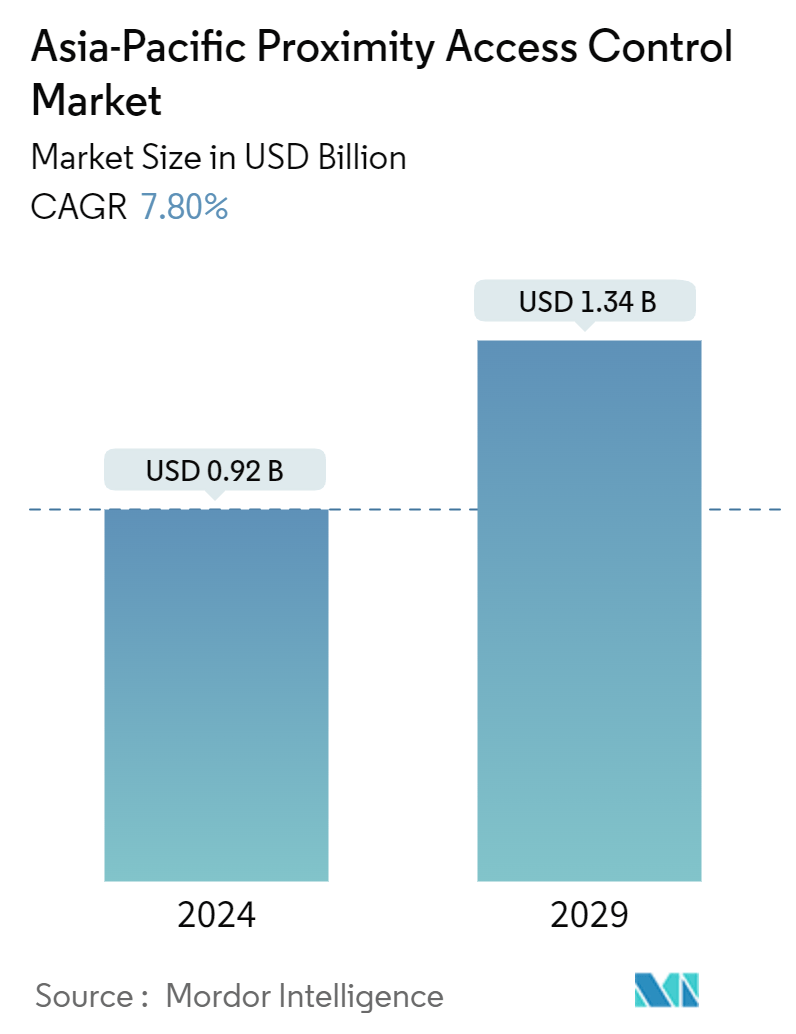Market Size of Asia-Pacific Proximity Access Control Industry

| Study Period | 2019 - 2029 |
| Base Year For Estimation | 2023 |
| Market Size (2024) | USD 0.92 Billion |
| Market Size (2029) | USD 1.34 Billion |
| CAGR (2024 - 2029) | 7.80 % |
| Market Concentration | Low |
Major Players
*Disclaimer: Major Players sorted in no particular order |
Asia-Pacific Proximity Access Control Market Analysis
The Asia-Pacific Proximity Access Control Market size is estimated at USD 0.92 billion in 2024, and is expected to reach USD 1.34 billion by 2029, growing at a CAGR of 7.80% during the forecast period (2024-2029).
- The rapid urbanization and the development of residences and commercial establishments in countries such as India, China, and Japan have created a demand for proximity access control systems to control entry and security effectively. Proximity card readers enable contactless card reading, promoting hygienic access control for regular use. United Nations projections indicated that by 2050, the global urban population will surpass its rural counterpart. India's urban population is set to surge by 328 million between 2022 and 2047, a figure exceeding the entire population of the United States.
- Further, increasing security concerns and a corresponding rise in security budget allocations are poised to drive significant growth in electronic access control system sales. According to the National Crime Records Bureau (NCRB), India's reported crime rate in 2023 was 445.9 per 100,000 individuals. Theft was the most common crime, followed by robbery and assault. Similarly, the National Police Agency of Japan reported that in 2023, there were approximately 44.23 thousand instances of grand theft, with nearly 17.5 thousand of these occurring in non-residential properties.
- The accessibility of commercial properties is highly dependent on access control systems. Proximity readers have become increasingly popular across all commercial properties. A significant number of businesses have already adopted proximity access control systems as a means of allowing authorized personnel to access the premises. This system is highly adaptable and can be designed to the needs of each business. The emergence of heightened security concerns, both in private companies and public settings, has necessitated the implementation of advanced access control solutions to safeguard individuals and resources.
- Additionally, customers are drawn to proximity access control systems due to the development of biometrics, blockchain, wireless connectivity, and other technologies. Additionally, biometric security is a significant investment in developing production facilities. Biometric technology, known for its effective identification, authentication processes, and enhanced security for information systems, is gaining popularity, especially for controlling access to electronic resources.
- Further, a smaller card reading range will restrict the adoption of these types of cards for access control, as if a proximity card reader has a limited read range, users may face difficulties in card usage. The market's growth is hindered by a need for more awareness of the advantages of contemporary security solutions and the high installation costs associated with workplace access control systems.
- Additionally, data privacy and security concerns, particularly in Asia Pacific with strict data protection regulations, may impede the implementation of proximity access control systems that store sensitive user data.
- Further, the ongoing war between Russia and Ukraine has disrupted the global supply chain, particularly affecting the availability and cost of electronic components and raw materials used in access control systems. This is leading to delays in production and increased costs for manufacturers. The rising inflation rates have increased the cost of goods and services, including proximity access control systems. Higher costs are leading to reduced purchasing power for consumers and businesses, slowing down the market's growth.
Asia-Pacific Proximity Access Control Industry Segmentation
Proximity access control is widely used to prevent theft, burglary, and other security breaches. Access control is a wireless technology that allows access control devices to communicate with one another wirelessly. This technology is based on low-frequency radio frequency identification (RFID) technology, which means the operating frequency is limited to 120 kHz. The study tracks the revenue accrued through the sale of proximity access control systems by various players in Asia-Pacific. The study also tracks the key market parameters, underlying growth influencers, and major vendors operating in the industry, which supports the market estimations and growth rates during the forecast period. The study further analyses the overall impact of the aftereffects of the COVID-19 pandemic and other macroeconomic factors on the market. The report’s scope encompasses market sizing and forecasts for various market segments.
The Asia-Pacific proximity access control market is segmented by solution (hardware and software), type (card readers, biometric scanners, proximity readers, alarms, metal detectors, door controllers, and wireless locks), end-user industry (government services, banking and financial services, it and telecommunications, transportation and logistics, retail, healthcare, and residential), and country (China, Japan, India, and rest of Asia Pacific). The market sizes and forecasts are provided in terms of value (USD) for all the above segments.
| By Solution | |
| Hardware | |
| Software |
| By Type | |
| Card Readers | |
| Biometric Scanners | |
| Proximity Readers | |
| Alarms | |
| Metal Detectors | |
| Door Controllers | |
| Wireless Locks |
| By End-user Industry | |
| Government Services | |
| Banking and Financial Services | |
| IT and Telecommunications | |
| Transportation and Logistics | |
| Retail | |
| Healthcare | |
| Residential | |
| Other End-user Industries |
| By Country*** | |
| China | |
| Japan | |
| India |
Asia-Pacific Proximity Access Control Market Size Summary
The Asia-Pacific proximity access control market is experiencing significant growth, driven by rapid urbanization and the increasing need for security in residential and commercial establishments across countries like India, China, and Japan. The demand for proximity access control systems is fueled by the need for effective entry and security control, with proximity card readers offering contactless and hygienic access solutions. The market is further bolstered by rising security concerns, leading to increased budget allocations for electronic access control systems. The adoption of advanced technologies such as biometrics, blockchain, and wireless connectivity is enhancing the appeal of proximity access control systems, making them a preferred choice for businesses seeking to safeguard their premises. However, challenges such as high installation costs, limited awareness of modern security solutions, and data privacy concerns in the region may impede market growth.
The market is characterized by a competitive landscape with several key players striving to expand their presence through product innovations, strategic partnerships, and mergers and acquisitions. The integration of biometric technology, known for its effective identification and authentication processes, is gaining traction, particularly in sectors like banking, transportation, and government. The increasing connectivity provided by 5G networks in countries such as India, China, and Japan presents new opportunities for wireless proximity access control systems. Despite challenges like supply chain disruptions and rising inflation affecting costs, the market is poised for growth, driven by the demand for cost-effective and IoT-based security solutions across various sectors, including retail, hospitality, and residential complexes.
Asia-Pacific Proximity Access Control Market Size - Table of Contents
-
1. MARKET INSIGHTS
-
1.1 Market Overview
-
1.2 Industry Attractiveness - Porter's Five Forces Analysis
-
1.2.1 Bargaining Power of Suppliers
-
1.2.2 Bargaining Power of Consumers
-
1.2.3 Threat of New Entrants
-
1.2.4 Threat of Substitutes
-
1.2.5 Intensity of Competitive Rivalry
-
-
1.3 Impact of the Aftereffects of the COVID-19 Pandemic and Other Macroeconomic Factors on the Market
-
-
2. MARKET SEGMENTATION
-
2.1 By Solution
-
2.1.1 Hardware
-
2.1.2 Software
-
-
2.2 By Type
-
2.2.1 Card Readers
-
2.2.2 Biometric Scanners
-
2.2.3 Proximity Readers
-
2.2.4 Alarms
-
2.2.5 Metal Detectors
-
2.2.6 Door Controllers
-
2.2.7 Wireless Locks
-
-
2.3 By End-user Industry
-
2.3.1 Government Services
-
2.3.2 Banking and Financial Services
-
2.3.3 IT and Telecommunications
-
2.3.4 Transportation and Logistics
-
2.3.5 Retail
-
2.3.6 Healthcare
-
2.3.7 Residential
-
2.3.8 Other End-user Industries
-
-
2.4 By Country***
-
2.4.1 China
-
2.4.2 Japan
-
2.4.3 India
-
-
Asia-Pacific Proximity Access Control Market Size FAQs
How big is the Asia-Pacific Proximity Access Control Market?
The Asia-Pacific Proximity Access Control Market size is expected to reach USD 0.92 billion in 2024 and grow at a CAGR of 7.80% to reach USD 1.34 billion by 2029.
What is the current Asia-Pacific Proximity Access Control Market size?
In 2024, the Asia-Pacific Proximity Access Control Market size is expected to reach USD 0.92 billion.

